Comparative Financial Analysis of Daimler and Tesla (2014-2017)
VerifiedAdded on 2020/10/22
|33
|9497
|470
Report
AI Summary
This report presents a comprehensive financial analysis of Daimler and Tesla, two major players in the automotive industry, from 2014 to 2017. The analysis employs various financial techniques, including ratio analysis, horizontal analysis, and vertical analysis, to evaluate their financial positions and performance. Key areas of focus include liquidity, profitability, efficiency, and leverage ratios. The report contrasts and compares the financial performance of both companies, highlighting their strengths and weaknesses. Furthermore, it provides a critical analysis of the cash positions of both organizations during the specified period. The findings offer insights into the financial health and operational effectiveness of Daimler and Tesla, providing a comparative perspective on their financial strategies and outcomes. The report concludes with a summary of the key findings and a discussion of the implications for each company.

Financial Analysis Management
& Enterprise
& Enterprise
Paraphrase This Document
Need a fresh take? Get an instant paraphrase of this document with our AI Paraphraser
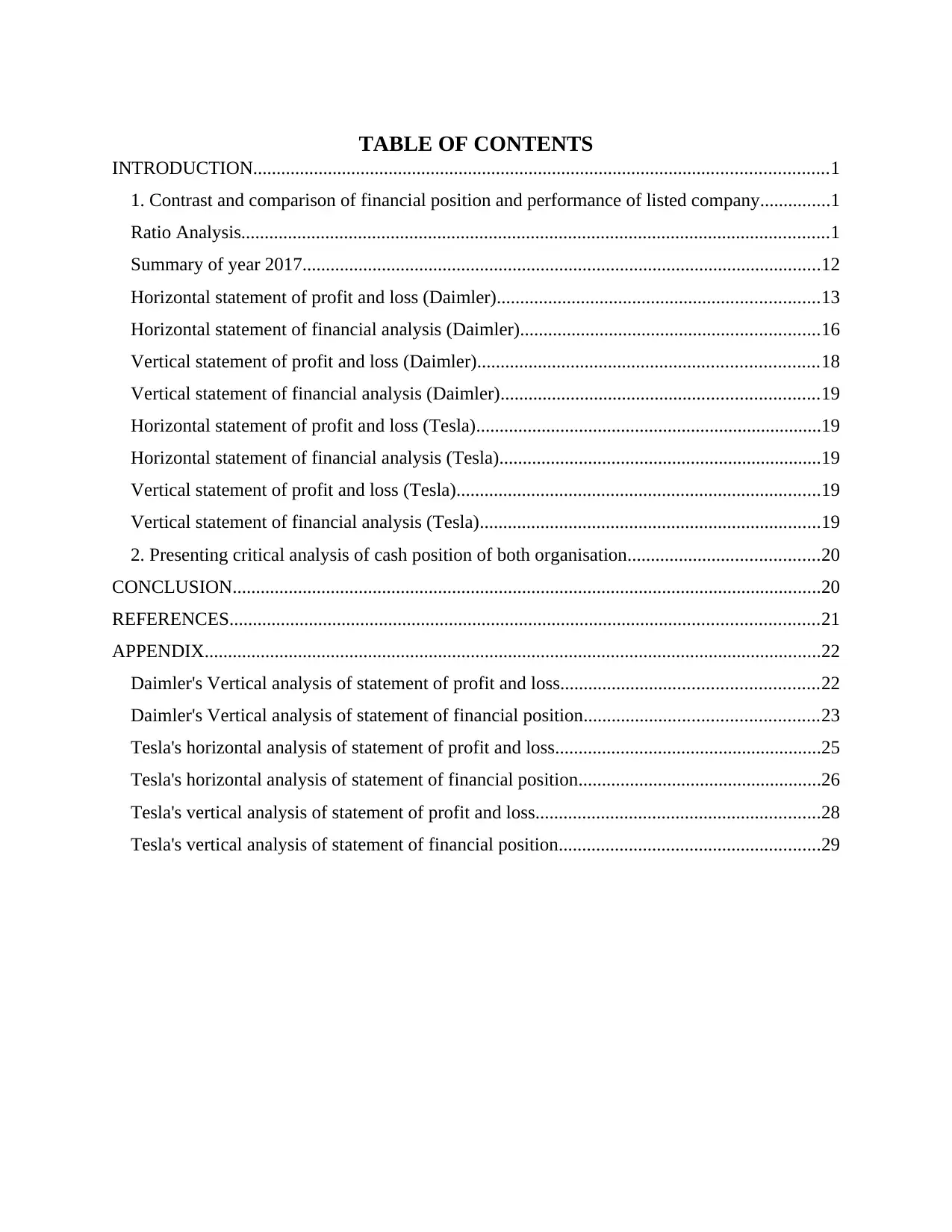
TABLE OF CONTENTS
INTRODUCTION...........................................................................................................................1
1. Contrast and comparison of financial position and performance of listed company...............1
Ratio Analysis..............................................................................................................................1
Summary of year 2017...............................................................................................................12
Horizontal statement of profit and loss (Daimler).....................................................................13
Horizontal statement of financial analysis (Daimler)................................................................16
Vertical statement of profit and loss (Daimler).........................................................................18
Vertical statement of financial analysis (Daimler)....................................................................19
Horizontal statement of profit and loss (Tesla)..........................................................................19
Horizontal statement of financial analysis (Tesla).....................................................................19
Vertical statement of profit and loss (Tesla)..............................................................................19
Vertical statement of financial analysis (Tesla).........................................................................19
2. Presenting critical analysis of cash position of both organisation.........................................20
CONCLUSION..............................................................................................................................20
REFERENCES..............................................................................................................................21
APPENDIX....................................................................................................................................22
Daimler's Vertical analysis of statement of profit and loss.......................................................22
Daimler's Vertical analysis of statement of financial position..................................................23
Tesla's horizontal analysis of statement of profit and loss.........................................................25
Tesla's horizontal analysis of statement of financial position....................................................26
Tesla's vertical analysis of statement of profit and loss.............................................................28
Tesla's vertical analysis of statement of financial position........................................................29
INTRODUCTION...........................................................................................................................1
1. Contrast and comparison of financial position and performance of listed company...............1
Ratio Analysis..............................................................................................................................1
Summary of year 2017...............................................................................................................12
Horizontal statement of profit and loss (Daimler).....................................................................13
Horizontal statement of financial analysis (Daimler)................................................................16
Vertical statement of profit and loss (Daimler).........................................................................18
Vertical statement of financial analysis (Daimler)....................................................................19
Horizontal statement of profit and loss (Tesla)..........................................................................19
Horizontal statement of financial analysis (Tesla).....................................................................19
Vertical statement of profit and loss (Tesla)..............................................................................19
Vertical statement of financial analysis (Tesla).........................................................................19
2. Presenting critical analysis of cash position of both organisation.........................................20
CONCLUSION..............................................................................................................................20
REFERENCES..............................................................................................................................21
APPENDIX....................................................................................................................................22
Daimler's Vertical analysis of statement of profit and loss.......................................................22
Daimler's Vertical analysis of statement of financial position..................................................23
Tesla's horizontal analysis of statement of profit and loss.........................................................25
Tesla's horizontal analysis of statement of financial position....................................................26
Tesla's vertical analysis of statement of profit and loss.............................................................28
Tesla's vertical analysis of statement of financial position........................................................29
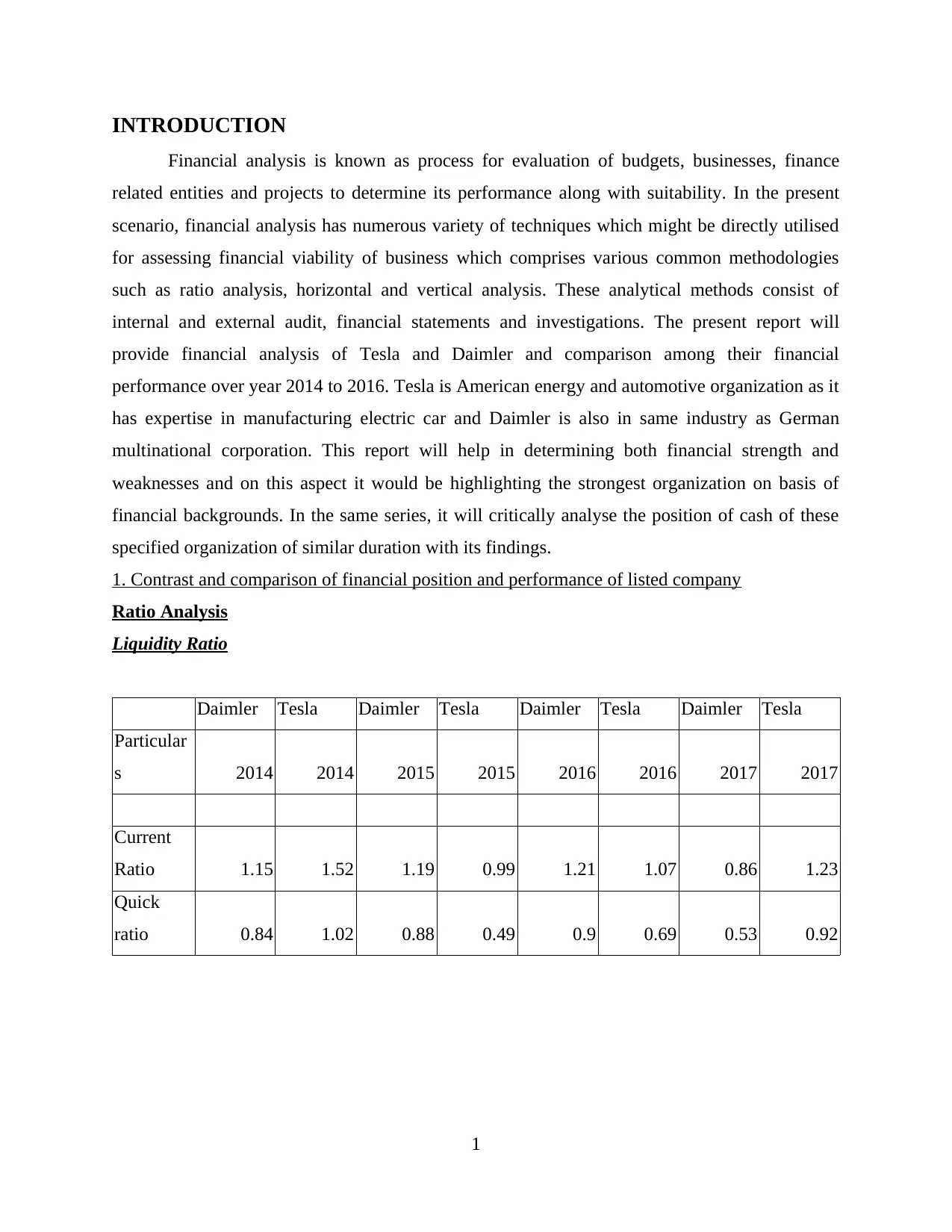
INTRODUCTION
Financial analysis is known as process for evaluation of budgets, businesses, finance
related entities and projects to determine its performance along with suitability. In the present
scenario, financial analysis has numerous variety of techniques which might be directly utilised
for assessing financial viability of business which comprises various common methodologies
such as ratio analysis, horizontal and vertical analysis. These analytical methods consist of
internal and external audit, financial statements and investigations. The present report will
provide financial analysis of Tesla and Daimler and comparison among their financial
performance over year 2014 to 2016. Tesla is American energy and automotive organization as it
has expertise in manufacturing electric car and Daimler is also in same industry as German
multinational corporation. This report will help in determining both financial strength and
weaknesses and on this aspect it would be highlighting the strongest organization on basis of
financial backgrounds. In the same series, it will critically analyse the position of cash of these
specified organization of similar duration with its findings.
1. Contrast and comparison of financial position and performance of listed company
Ratio Analysis
Liquidity Ratio
Daimler Tesla Daimler Tesla Daimler Tesla Daimler Tesla
Particular
s 2014 2014 2015 2015 2016 2016 2017 2017
Current
Ratio 1.15 1.52 1.19 0.99 1.21 1.07 0.86 1.23
Quick
ratio 0.84 1.02 0.88 0.49 0.9 0.69 0.53 0.92
1
Financial analysis is known as process for evaluation of budgets, businesses, finance
related entities and projects to determine its performance along with suitability. In the present
scenario, financial analysis has numerous variety of techniques which might be directly utilised
for assessing financial viability of business which comprises various common methodologies
such as ratio analysis, horizontal and vertical analysis. These analytical methods consist of
internal and external audit, financial statements and investigations. The present report will
provide financial analysis of Tesla and Daimler and comparison among their financial
performance over year 2014 to 2016. Tesla is American energy and automotive organization as it
has expertise in manufacturing electric car and Daimler is also in same industry as German
multinational corporation. This report will help in determining both financial strength and
weaknesses and on this aspect it would be highlighting the strongest organization on basis of
financial backgrounds. In the same series, it will critically analyse the position of cash of these
specified organization of similar duration with its findings.
1. Contrast and comparison of financial position and performance of listed company
Ratio Analysis
Liquidity Ratio
Daimler Tesla Daimler Tesla Daimler Tesla Daimler Tesla
Particular
s 2014 2014 2015 2015 2016 2016 2017 2017
Current
Ratio 1.15 1.52 1.19 0.99 1.21 1.07 0.86 1.23
Quick
ratio 0.84 1.02 0.88 0.49 0.9 0.69 0.53 0.92
1
⊘ This is a preview!⊘
Do you want full access?
Subscribe today to unlock all pages.

Trusted by 1+ million students worldwide
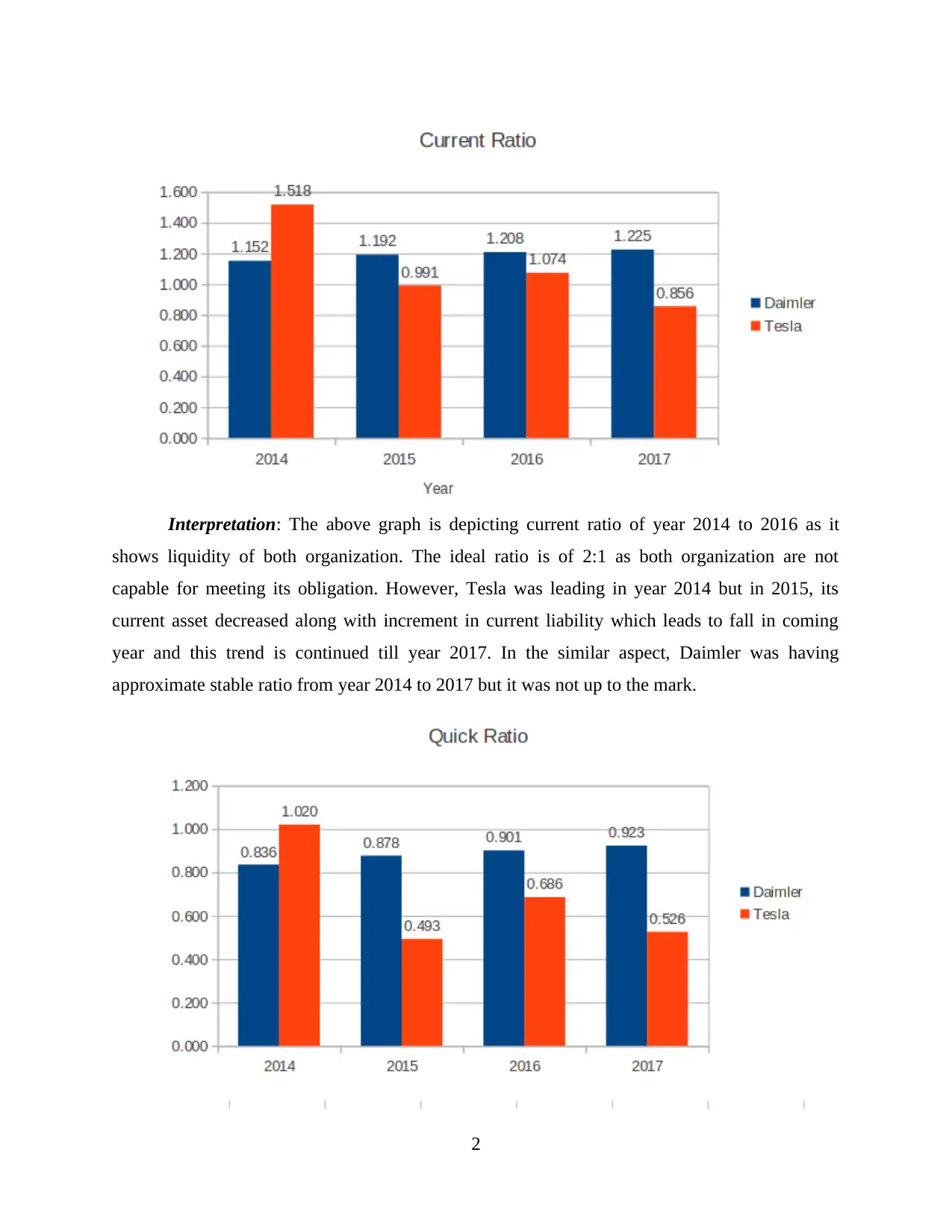
Interpretation: The above graph is depicting current ratio of year 2014 to 2016 as it
shows liquidity of both organization. The ideal ratio is of 2:1 as both organization are not
capable for meeting its obligation. However, Tesla was leading in year 2014 but in 2015, its
current asset decreased along with increment in current liability which leads to fall in coming
year and this trend is continued till year 2017. In the similar aspect, Daimler was having
approximate stable ratio from year 2014 to 2017 but it was not up to the mark.
2
shows liquidity of both organization. The ideal ratio is of 2:1 as both organization are not
capable for meeting its obligation. However, Tesla was leading in year 2014 but in 2015, its
current asset decreased along with increment in current liability which leads to fall in coming
year and this trend is continued till year 2017. In the similar aspect, Daimler was having
approximate stable ratio from year 2014 to 2017 but it was not up to the mark.
2
Paraphrase This Document
Need a fresh take? Get an instant paraphrase of this document with our AI Paraphraser
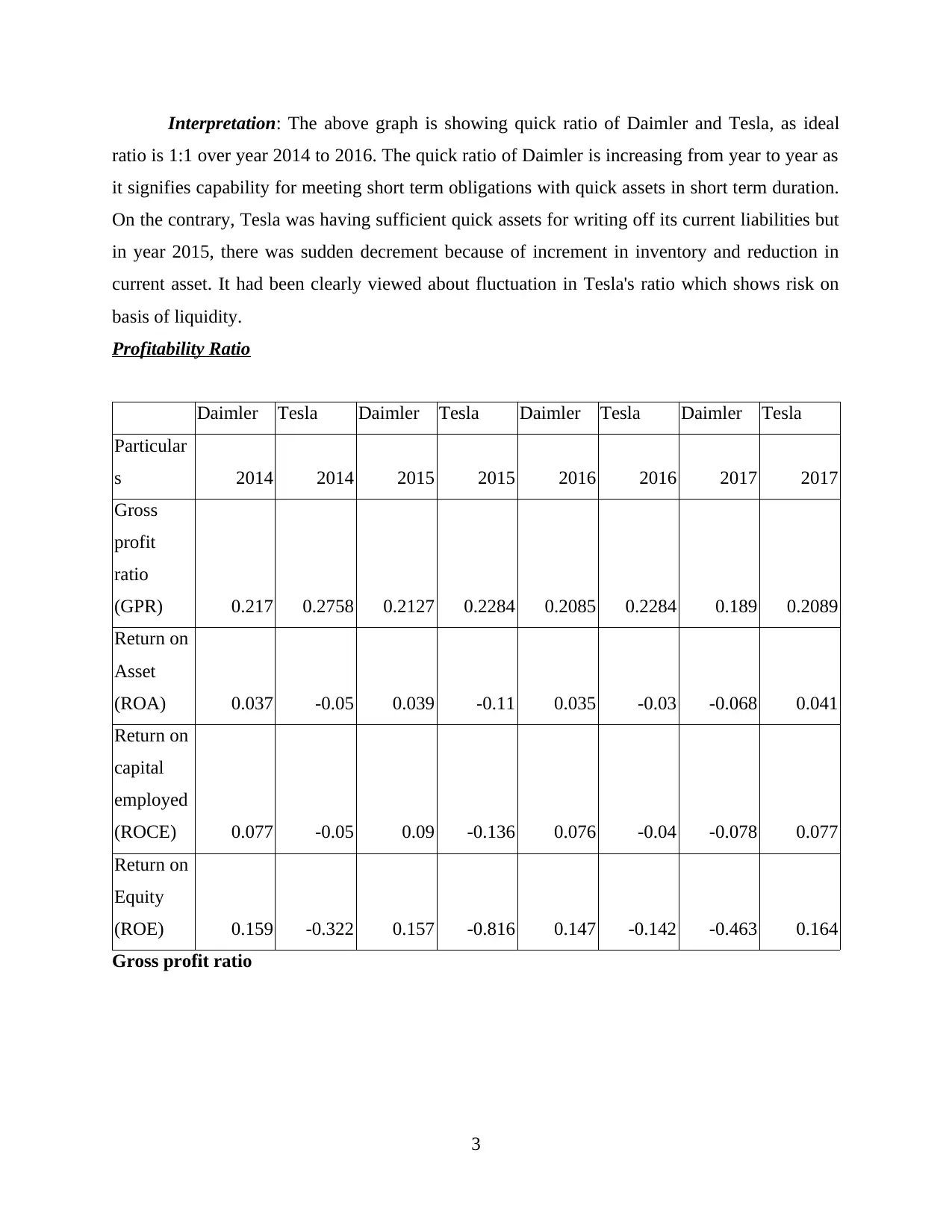
Interpretation: The above graph is showing quick ratio of Daimler and Tesla, as ideal
ratio is 1:1 over year 2014 to 2016. The quick ratio of Daimler is increasing from year to year as
it signifies capability for meeting short term obligations with quick assets in short term duration.
On the contrary, Tesla was having sufficient quick assets for writing off its current liabilities but
in year 2015, there was sudden decrement because of increment in inventory and reduction in
current asset. It had been clearly viewed about fluctuation in Tesla's ratio which shows risk on
basis of liquidity.
Profitability Ratio
Daimler Tesla Daimler Tesla Daimler Tesla Daimler Tesla
Particular
s 2014 2014 2015 2015 2016 2016 2017 2017
Gross
profit
ratio
(GPR) 0.217 0.2758 0.2127 0.2284 0.2085 0.2284 0.189 0.2089
Return on
Asset
(ROA) 0.037 -0.05 0.039 -0.11 0.035 -0.03 -0.068 0.041
Return on
capital
employed
(ROCE) 0.077 -0.05 0.09 -0.136 0.076 -0.04 -0.078 0.077
Return on
Equity
(ROE) 0.159 -0.322 0.157 -0.816 0.147 -0.142 -0.463 0.164
Gross profit ratio
3
ratio is 1:1 over year 2014 to 2016. The quick ratio of Daimler is increasing from year to year as
it signifies capability for meeting short term obligations with quick assets in short term duration.
On the contrary, Tesla was having sufficient quick assets for writing off its current liabilities but
in year 2015, there was sudden decrement because of increment in inventory and reduction in
current asset. It had been clearly viewed about fluctuation in Tesla's ratio which shows risk on
basis of liquidity.
Profitability Ratio
Daimler Tesla Daimler Tesla Daimler Tesla Daimler Tesla
Particular
s 2014 2014 2015 2015 2016 2016 2017 2017
Gross
profit
ratio
(GPR) 0.217 0.2758 0.2127 0.2284 0.2085 0.2284 0.189 0.2089
Return on
Asset
(ROA) 0.037 -0.05 0.039 -0.11 0.035 -0.03 -0.068 0.041
Return on
capital
employed
(ROCE) 0.077 -0.05 0.09 -0.136 0.076 -0.04 -0.078 0.077
Return on
Equity
(ROE) 0.159 -0.322 0.157 -0.816 0.147 -0.142 -0.463 0.164
Gross profit ratio
3
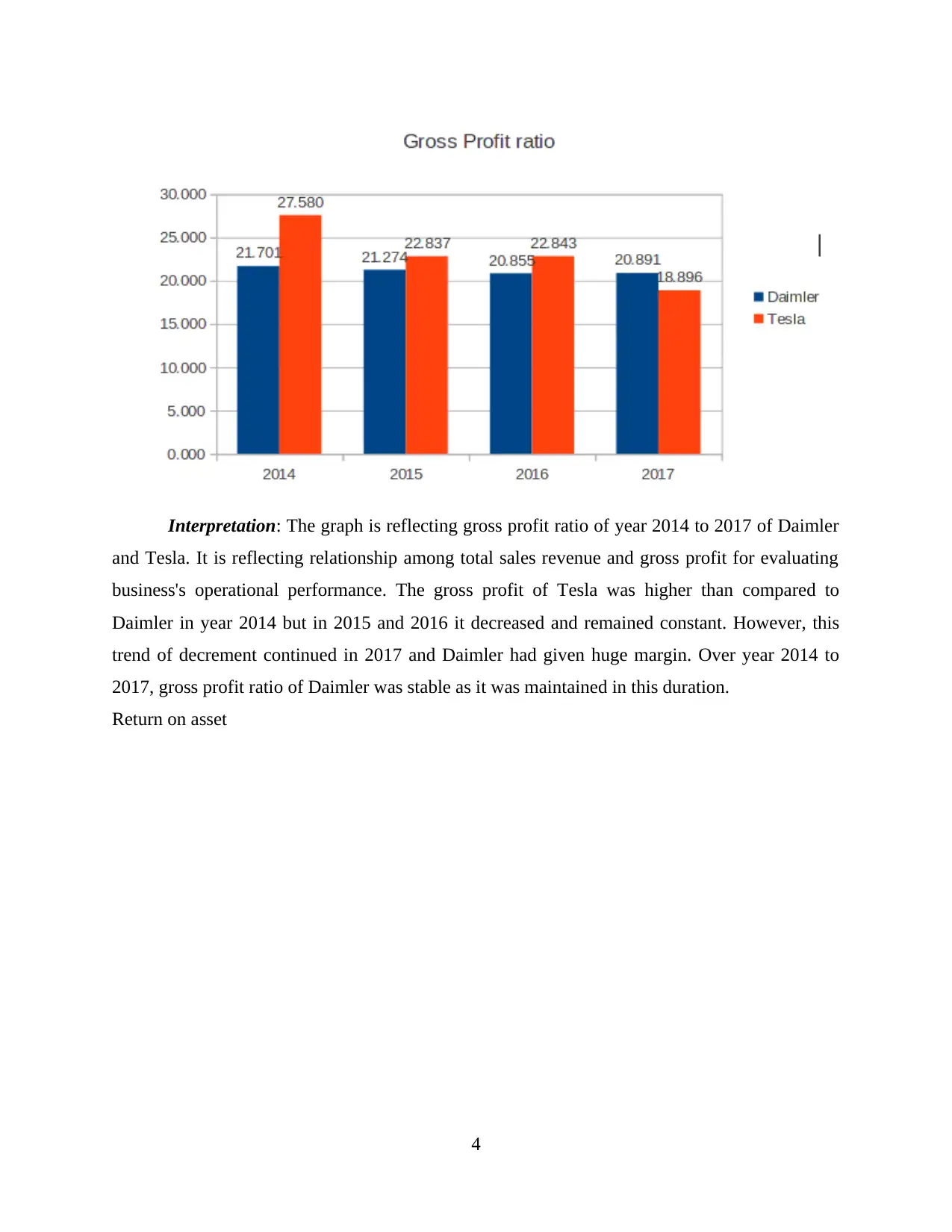
Interpretation: The graph is reflecting gross profit ratio of year 2014 to 2017 of Daimler
and Tesla. It is reflecting relationship among total sales revenue and gross profit for evaluating
business's operational performance. The gross profit of Tesla was higher than compared to
Daimler in year 2014 but in 2015 and 2016 it decreased and remained constant. However, this
trend of decrement continued in 2017 and Daimler had given huge margin. Over year 2014 to
2017, gross profit ratio of Daimler was stable as it was maintained in this duration.
Return on asset
4
and Tesla. It is reflecting relationship among total sales revenue and gross profit for evaluating
business's operational performance. The gross profit of Tesla was higher than compared to
Daimler in year 2014 but in 2015 and 2016 it decreased and remained constant. However, this
trend of decrement continued in 2017 and Daimler had given huge margin. Over year 2014 to
2017, gross profit ratio of Daimler was stable as it was maintained in this duration.
Return on asset
4
⊘ This is a preview!⊘
Do you want full access?
Subscribe today to unlock all pages.

Trusted by 1+ million students worldwide
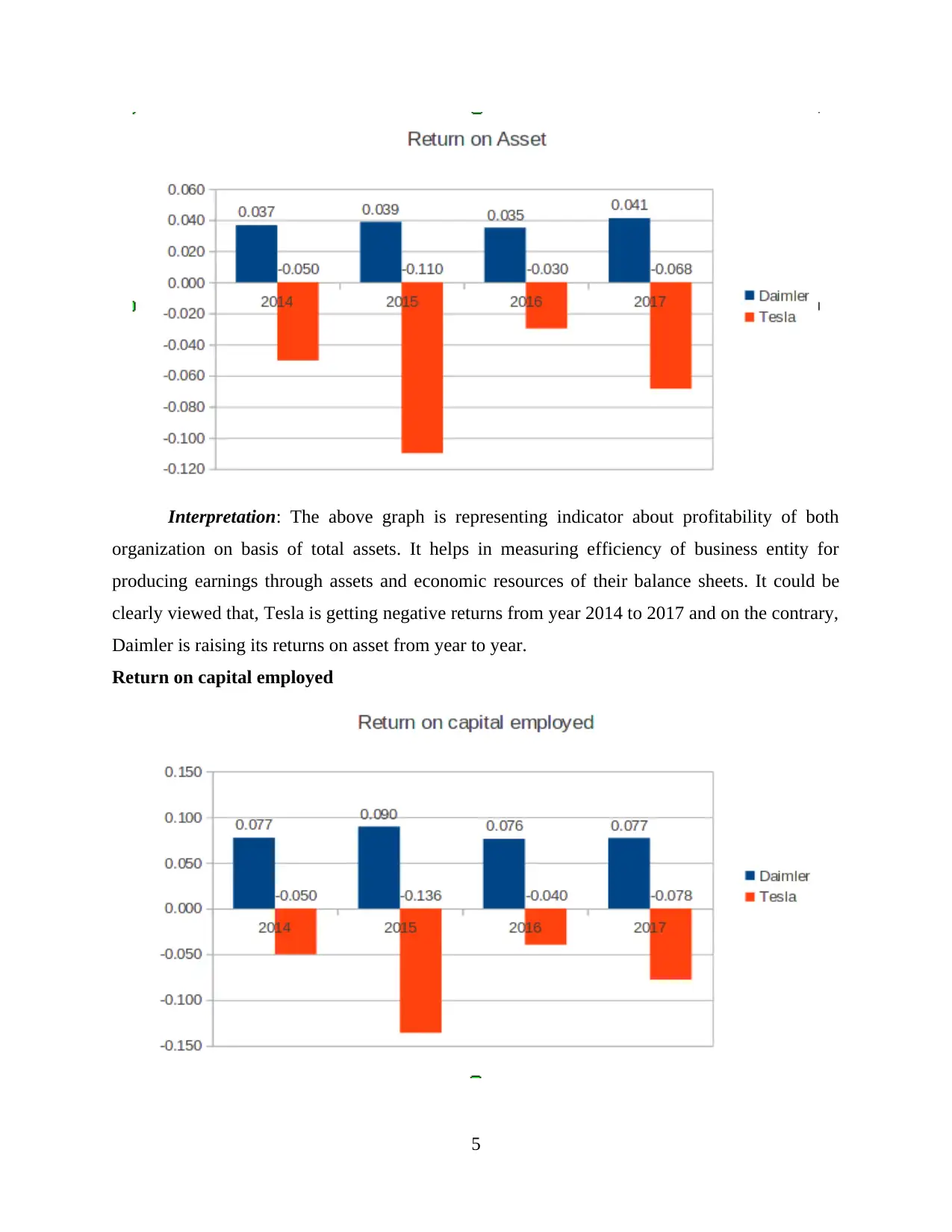
Interpretation: The above graph is representing indicator about profitability of both
organization on basis of total assets. It helps in measuring efficiency of business entity for
producing earnings through assets and economic resources of their balance sheets. It could be
clearly viewed that, Tesla is getting negative returns from year 2014 to 2017 and on the contrary,
Daimler is raising its returns on asset from year to year.
Return on capital employed
5
organization on basis of total assets. It helps in measuring efficiency of business entity for
producing earnings through assets and economic resources of their balance sheets. It could be
clearly viewed that, Tesla is getting negative returns from year 2014 to 2017 and on the contrary,
Daimler is raising its returns on asset from year to year.
Return on capital employed
5
Paraphrase This Document
Need a fresh take? Get an instant paraphrase of this document with our AI Paraphraser
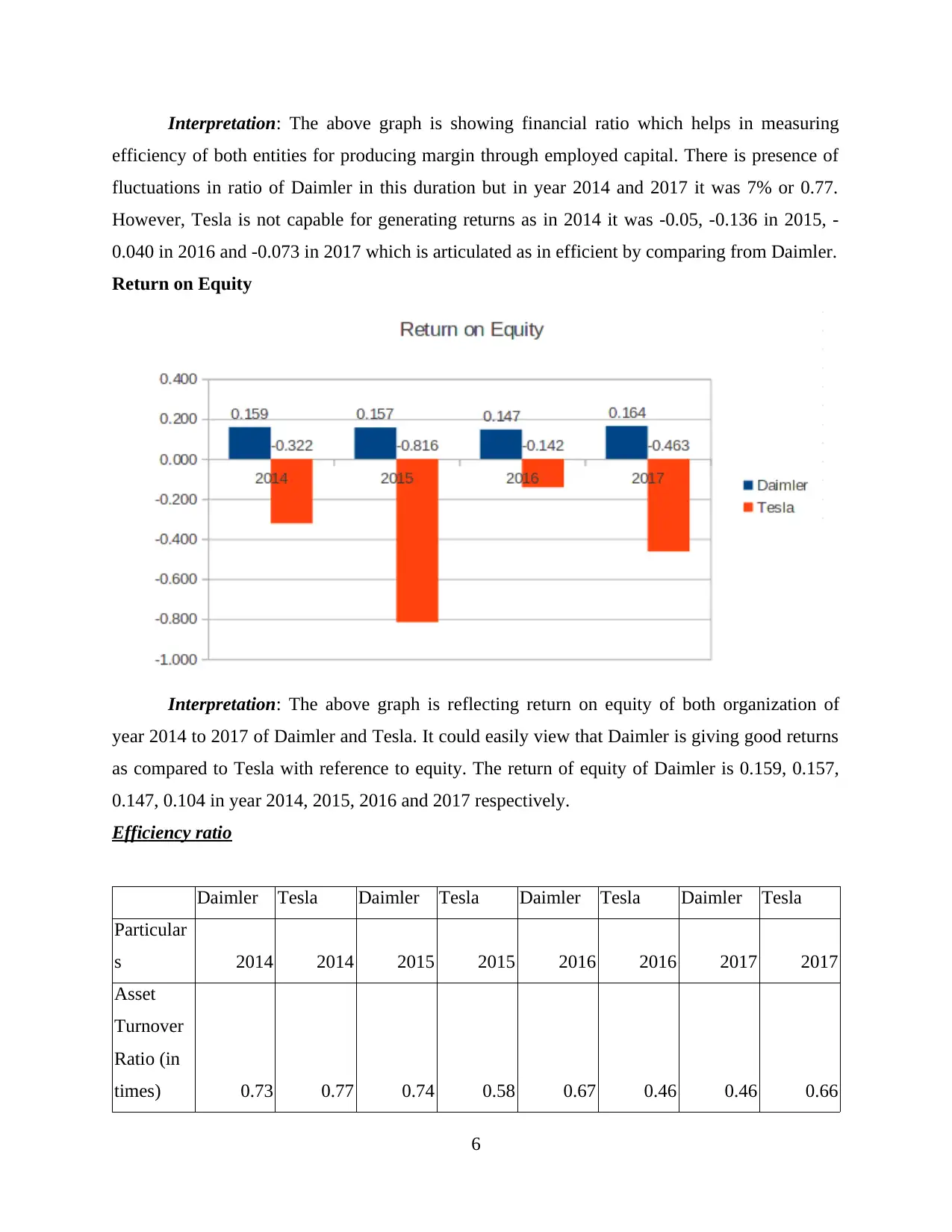
Interpretation: The above graph is showing financial ratio which helps in measuring
efficiency of both entities for producing margin through employed capital. There is presence of
fluctuations in ratio of Daimler in this duration but in year 2014 and 2017 it was 7% or 0.77.
However, Tesla is not capable for generating returns as in 2014 it was -0.05, -0.136 in 2015, -
0.040 in 2016 and -0.073 in 2017 which is articulated as in efficient by comparing from Daimler.
Return on Equity
Interpretation: The above graph is reflecting return on equity of both organization of
year 2014 to 2017 of Daimler and Tesla. It could easily view that Daimler is giving good returns
as compared to Tesla with reference to equity. The return of equity of Daimler is 0.159, 0.157,
0.147, 0.104 in year 2014, 2015, 2016 and 2017 respectively.
Efficiency ratio
Daimler Tesla Daimler Tesla Daimler Tesla Daimler Tesla
Particular
s 2014 2014 2015 2015 2016 2016 2017 2017
Asset
Turnover
Ratio (in
times) 0.73 0.77 0.74 0.58 0.67 0.46 0.46 0.66
6
efficiency of both entities for producing margin through employed capital. There is presence of
fluctuations in ratio of Daimler in this duration but in year 2014 and 2017 it was 7% or 0.77.
However, Tesla is not capable for generating returns as in 2014 it was -0.05, -0.136 in 2015, -
0.040 in 2016 and -0.073 in 2017 which is articulated as in efficient by comparing from Daimler.
Return on Equity
Interpretation: The above graph is reflecting return on equity of both organization of
year 2014 to 2017 of Daimler and Tesla. It could easily view that Daimler is giving good returns
as compared to Tesla with reference to equity. The return of equity of Daimler is 0.159, 0.157,
0.147, 0.104 in year 2014, 2015, 2016 and 2017 respectively.
Efficiency ratio
Daimler Tesla Daimler Tesla Daimler Tesla Daimler Tesla
Particular
s 2014 2014 2015 2015 2016 2016 2017 2017
Asset
Turnover
Ratio (in
times) 0.73 0.77 0.74 0.58 0.67 0.46 0.46 0.66
6
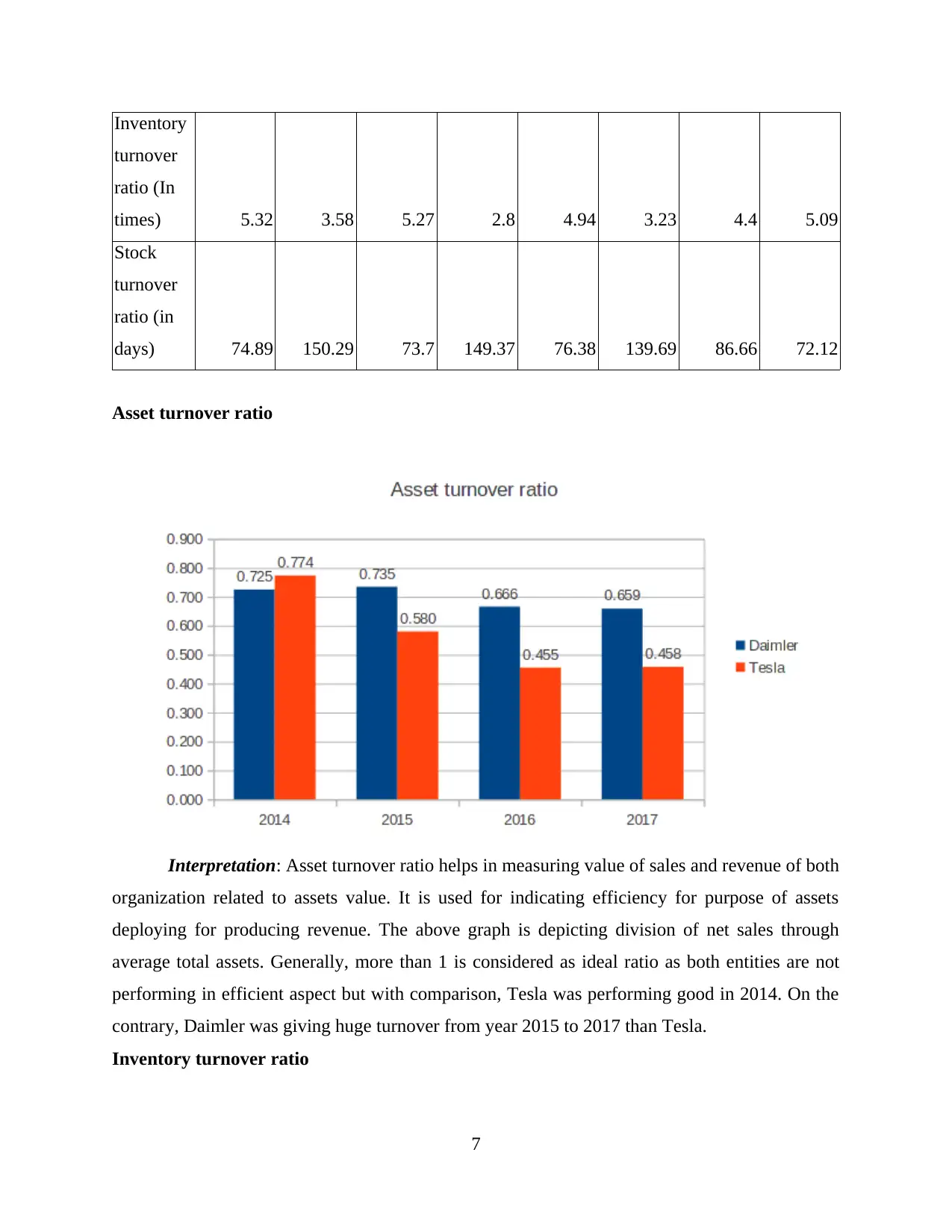
Inventory
turnover
ratio (In
times) 5.32 3.58 5.27 2.8 4.94 3.23 4.4 5.09
Stock
turnover
ratio (in
days) 74.89 150.29 73.7 149.37 76.38 139.69 86.66 72.12
Asset turnover ratio
Interpretation: Asset turnover ratio helps in measuring value of sales and revenue of both
organization related to assets value. It is used for indicating efficiency for purpose of assets
deploying for producing revenue. The above graph is depicting division of net sales through
average total assets. Generally, more than 1 is considered as ideal ratio as both entities are not
performing in efficient aspect but with comparison, Tesla was performing good in 2014. On the
contrary, Daimler was giving huge turnover from year 2015 to 2017 than Tesla.
Inventory turnover ratio
7
turnover
ratio (In
times) 5.32 3.58 5.27 2.8 4.94 3.23 4.4 5.09
Stock
turnover
ratio (in
days) 74.89 150.29 73.7 149.37 76.38 139.69 86.66 72.12
Asset turnover ratio
Interpretation: Asset turnover ratio helps in measuring value of sales and revenue of both
organization related to assets value. It is used for indicating efficiency for purpose of assets
deploying for producing revenue. The above graph is depicting division of net sales through
average total assets. Generally, more than 1 is considered as ideal ratio as both entities are not
performing in efficient aspect but with comparison, Tesla was performing good in 2014. On the
contrary, Daimler was giving huge turnover from year 2015 to 2017 than Tesla.
Inventory turnover ratio
7
⊘ This is a preview!⊘
Do you want full access?
Subscribe today to unlock all pages.

Trusted by 1+ million students worldwide
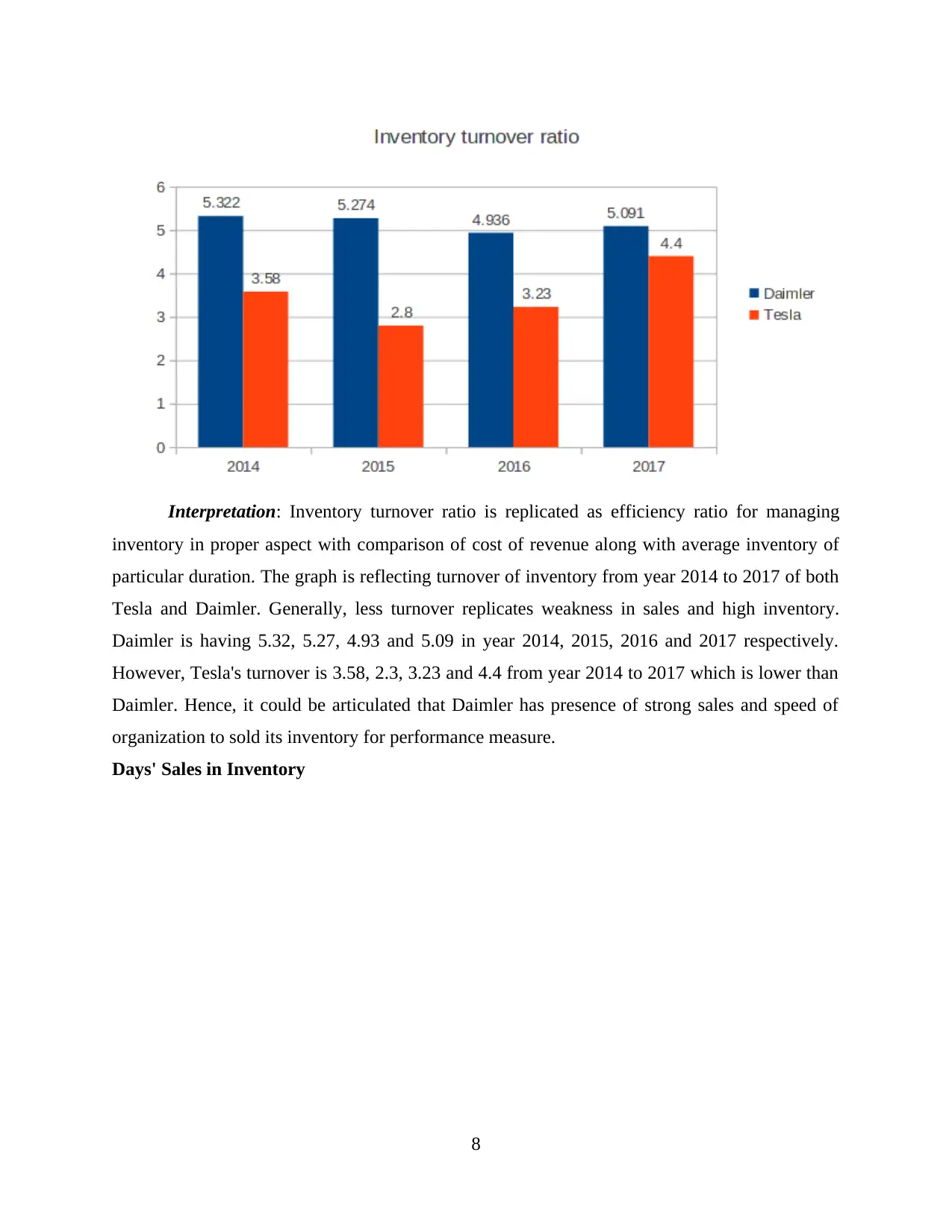
Interpretation: Inventory turnover ratio is replicated as efficiency ratio for managing
inventory in proper aspect with comparison of cost of revenue along with average inventory of
particular duration. The graph is reflecting turnover of inventory from year 2014 to 2017 of both
Tesla and Daimler. Generally, less turnover replicates weakness in sales and high inventory.
Daimler is having 5.32, 5.27, 4.93 and 5.09 in year 2014, 2015, 2016 and 2017 respectively.
However, Tesla's turnover is 3.58, 2.3, 3.23 and 4.4 from year 2014 to 2017 which is lower than
Daimler. Hence, it could be articulated that Daimler has presence of strong sales and speed of
organization to sold its inventory for performance measure.
Days' Sales in Inventory
8
inventory in proper aspect with comparison of cost of revenue along with average inventory of
particular duration. The graph is reflecting turnover of inventory from year 2014 to 2017 of both
Tesla and Daimler. Generally, less turnover replicates weakness in sales and high inventory.
Daimler is having 5.32, 5.27, 4.93 and 5.09 in year 2014, 2015, 2016 and 2017 respectively.
However, Tesla's turnover is 3.58, 2.3, 3.23 and 4.4 from year 2014 to 2017 which is lower than
Daimler. Hence, it could be articulated that Daimler has presence of strong sales and speed of
organization to sold its inventory for performance measure.
Days' Sales in Inventory
8
Paraphrase This Document
Need a fresh take? Get an instant paraphrase of this document with our AI Paraphraser
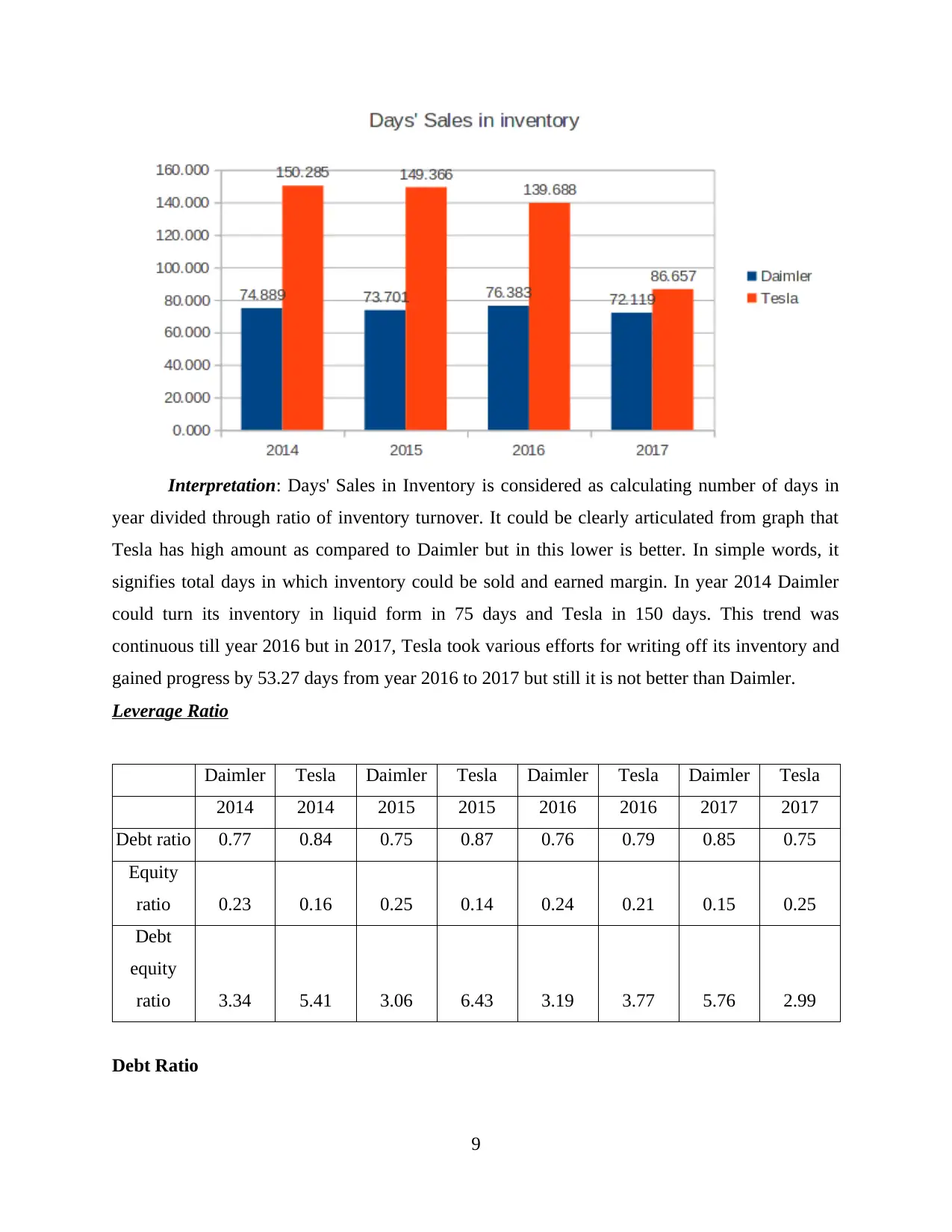
Interpretation: Days' Sales in Inventory is considered as calculating number of days in
year divided through ratio of inventory turnover. It could be clearly articulated from graph that
Tesla has high amount as compared to Daimler but in this lower is better. In simple words, it
signifies total days in which inventory could be sold and earned margin. In year 2014 Daimler
could turn its inventory in liquid form in 75 days and Tesla in 150 days. This trend was
continuous till year 2016 but in 2017, Tesla took various efforts for writing off its inventory and
gained progress by 53.27 days from year 2016 to 2017 but still it is not better than Daimler.
Leverage Ratio
Daimler Tesla Daimler Tesla Daimler Tesla Daimler Tesla
2014 2014 2015 2015 2016 2016 2017 2017
Debt ratio 0.77 0.84 0.75 0.87 0.76 0.79 0.85 0.75
Equity
ratio 0.23 0.16 0.25 0.14 0.24 0.21 0.15 0.25
Debt
equity
ratio 3.34 5.41 3.06 6.43 3.19 3.77 5.76 2.99
Debt Ratio
9
year divided through ratio of inventory turnover. It could be clearly articulated from graph that
Tesla has high amount as compared to Daimler but in this lower is better. In simple words, it
signifies total days in which inventory could be sold and earned margin. In year 2014 Daimler
could turn its inventory in liquid form in 75 days and Tesla in 150 days. This trend was
continuous till year 2016 but in 2017, Tesla took various efforts for writing off its inventory and
gained progress by 53.27 days from year 2016 to 2017 but still it is not better than Daimler.
Leverage Ratio
Daimler Tesla Daimler Tesla Daimler Tesla Daimler Tesla
2014 2014 2015 2015 2016 2016 2017 2017
Debt ratio 0.77 0.84 0.75 0.87 0.76 0.79 0.85 0.75
Equity
ratio 0.23 0.16 0.25 0.14 0.24 0.21 0.15 0.25
Debt
equity
ratio 3.34 5.41 3.06 6.43 3.19 3.77 5.76 2.99
Debt Ratio
9
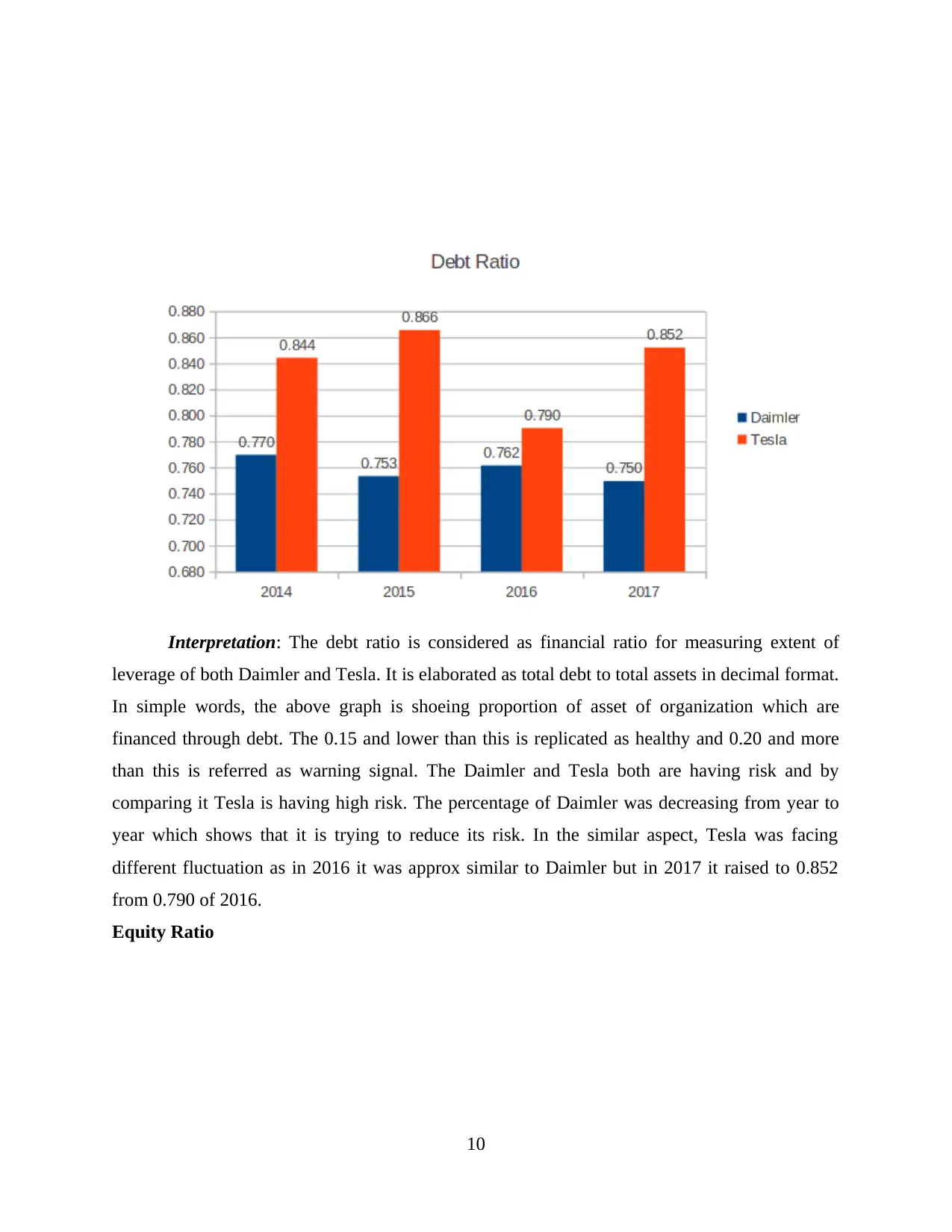
Interpretation: The debt ratio is considered as financial ratio for measuring extent of
leverage of both Daimler and Tesla. It is elaborated as total debt to total assets in decimal format.
In simple words, the above graph is shoeing proportion of asset of organization which are
financed through debt. The 0.15 and lower than this is replicated as healthy and 0.20 and more
than this is referred as warning signal. The Daimler and Tesla both are having risk and by
comparing it Tesla is having high risk. The percentage of Daimler was decreasing from year to
year which shows that it is trying to reduce its risk. In the similar aspect, Tesla was facing
different fluctuation as in 2016 it was approx similar to Daimler but in 2017 it raised to 0.852
from 0.790 of 2016.
Equity Ratio
10
leverage of both Daimler and Tesla. It is elaborated as total debt to total assets in decimal format.
In simple words, the above graph is shoeing proportion of asset of organization which are
financed through debt. The 0.15 and lower than this is replicated as healthy and 0.20 and more
than this is referred as warning signal. The Daimler and Tesla both are having risk and by
comparing it Tesla is having high risk. The percentage of Daimler was decreasing from year to
year which shows that it is trying to reduce its risk. In the similar aspect, Tesla was facing
different fluctuation as in 2016 it was approx similar to Daimler but in 2017 it raised to 0.852
from 0.790 of 2016.
Equity Ratio
10
⊘ This is a preview!⊘
Do you want full access?
Subscribe today to unlock all pages.

Trusted by 1+ million students worldwide
1 out of 33
Related Documents
Your All-in-One AI-Powered Toolkit for Academic Success.
+13062052269
info@desklib.com
Available 24*7 on WhatsApp / Email
![[object Object]](/_next/static/media/star-bottom.7253800d.svg)
Unlock your academic potential
Copyright © 2020–2025 A2Z Services. All Rights Reserved. Developed and managed by ZUCOL.





